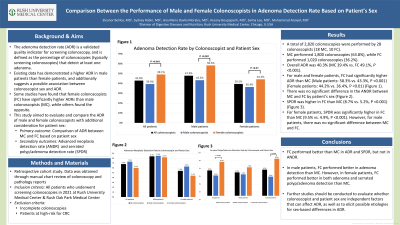Tuesday Poster Session
Category: Colorectal Cancer Prevention
P3208 - Comparison Between the Performance of Male and Female Colonoscopists in Adenoma Detection Rate Based on Patient’s Sex
Tuesday, October 24, 2023
10:30 AM - 4:00 PM PT
Location: Exhibit Hall

Has Audio

Eleanor Belilos, MD
Rush University Medical Center
Chicago, IL
Presenting Author(s)
Eleanor Belilos, MD, Sydney Rabin, MD, Ana Maria Davila Morales, MD, Kesany Boupapanh, MD, Salina Lee, MD, Muhammad Alsayid, MD
Rush University Medical Center, Chicago, IL
Introduction: The adenoma detection rate (ADR) of a patient’s colonoscopist affects interval colorectal cancer (CRC) rates. Previous data has demonstrated a higher ADR in male patients than female patients, and additionally suggests a possible association between colonoscopist sex and ADR. Some studies have found that female colonoscopists (FC) have higher ADRs than male colonoscopists (MC), while others found the opposite or were inconclusive. Data is especially limited regarding the association of patient sex with male and female colonoscopists’ ADR performance. This study aimed to evaluate and compare the ADR of male and female colonoscopists with additional consideration for patient sex.
Methods: A retrospective cohort study of patients who underwent screening colonoscopies in 2021 was conducted. Incomplete colonoscopies and patients at high-risk for CRC were excluded. Data was obtained through manual chart review of colonoscopy and pathology reports. The primary outcome of the study was the comparison of ADR between MC and FC based on patient sex. Secondary outcomes included advanced neoplasia detection rate (ANDR) and serrated polyp/adenoma detection rate (SPDR).
Results: A total of 2,820 colonoscopies were performed by 28 colonoscopists (18 MC, 10 FC). MC performed 1,800 colonoscopies (63.8%), while FC performed 1,020 colonoscopies (36.2%). Overall ADR was 40.3% (MC 39.4% vs. FC 49.1%, P < 0.001) (Table 1). For male and female patients, FC had significantly higher ADR than MC (Male patients: 58.3% vs. 43.3%, P < 0.001) (Female patients: 44.2% vs. 36.4%, P < 0.01) (Figure 1). There was no significant difference in the ANDR between MC and FC by patient’s sex (Figure 2). SPDR was higher in FC than MC (8.7% vs. 5.2%, P < 0.001) (Figure 3). For female patients, SPDR was significantly higher in FC than MC (9.5% vs. 4.9%, P < 0.001). However, for male patients, there was no significant difference between MC and FC.
Discussion: Female colonoscopists performed better than male colonoscopists in ADR and SPDR, but not in ANDR. In male patients, FC performed better in adenoma detection than MC. However, in female patients, FC performed better in both adenoma and serrated polyp/adenoma detection than MC. Further studies should be conducted to evaluate whether colonoscopist and patient sex are independent factors that can affect ADR, as well as to elicit possible etiologies for sex-based differences in ADR.

Disclosures:
Eleanor Belilos, MD, Sydney Rabin, MD, Ana Maria Davila Morales, MD, Kesany Boupapanh, MD, Salina Lee, MD, Muhammad Alsayid, MD. P3208 - Comparison Between the Performance of Male and Female Colonoscopists in Adenoma Detection Rate Based on Patient’s Sex, ACG 2023 Annual Scientific Meeting Abstracts. Vancouver, BC, Canada: American College of Gastroenterology.
Rush University Medical Center, Chicago, IL
Introduction: The adenoma detection rate (ADR) of a patient’s colonoscopist affects interval colorectal cancer (CRC) rates. Previous data has demonstrated a higher ADR in male patients than female patients, and additionally suggests a possible association between colonoscopist sex and ADR. Some studies have found that female colonoscopists (FC) have higher ADRs than male colonoscopists (MC), while others found the opposite or were inconclusive. Data is especially limited regarding the association of patient sex with male and female colonoscopists’ ADR performance. This study aimed to evaluate and compare the ADR of male and female colonoscopists with additional consideration for patient sex.
Methods: A retrospective cohort study of patients who underwent screening colonoscopies in 2021 was conducted. Incomplete colonoscopies and patients at high-risk for CRC were excluded. Data was obtained through manual chart review of colonoscopy and pathology reports. The primary outcome of the study was the comparison of ADR between MC and FC based on patient sex. Secondary outcomes included advanced neoplasia detection rate (ANDR) and serrated polyp/adenoma detection rate (SPDR).
Results: A total of 2,820 colonoscopies were performed by 28 colonoscopists (18 MC, 10 FC). MC performed 1,800 colonoscopies (63.8%), while FC performed 1,020 colonoscopies (36.2%). Overall ADR was 40.3% (MC 39.4% vs. FC 49.1%, P < 0.001) (Table 1). For male and female patients, FC had significantly higher ADR than MC (Male patients: 58.3% vs. 43.3%, P < 0.001) (Female patients: 44.2% vs. 36.4%, P < 0.01) (Figure 1). There was no significant difference in the ANDR between MC and FC by patient’s sex (Figure 2). SPDR was higher in FC than MC (8.7% vs. 5.2%, P < 0.001) (Figure 3). For female patients, SPDR was significantly higher in FC than MC (9.5% vs. 4.9%, P < 0.001). However, for male patients, there was no significant difference between MC and FC.
Discussion: Female colonoscopists performed better than male colonoscopists in ADR and SPDR, but not in ANDR. In male patients, FC performed better in adenoma detection than MC. However, in female patients, FC performed better in both adenoma and serrated polyp/adenoma detection than MC. Further studies should be conducted to evaluate whether colonoscopist and patient sex are independent factors that can affect ADR, as well as to elicit possible etiologies for sex-based differences in ADR.

Figure: Adenoma detection rate, advanced neoplasia detection rate, and serrated polyp/adenoma detection rate by colonoscopist and patient sex.
Disclosures:
Eleanor Belilos indicated no relevant financial relationships.
Sydney Rabin indicated no relevant financial relationships.
Ana Maria Davila Morales indicated no relevant financial relationships.
Kesany Boupapanh indicated no relevant financial relationships.
Salina Lee indicated no relevant financial relationships.
Muhammad Alsayid indicated no relevant financial relationships.
Eleanor Belilos, MD, Sydney Rabin, MD, Ana Maria Davila Morales, MD, Kesany Boupapanh, MD, Salina Lee, MD, Muhammad Alsayid, MD. P3208 - Comparison Between the Performance of Male and Female Colonoscopists in Adenoma Detection Rate Based on Patient’s Sex, ACG 2023 Annual Scientific Meeting Abstracts. Vancouver, BC, Canada: American College of Gastroenterology.
